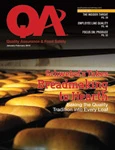For generations of Americans, bed bugs meant no more than a good night saying to a child: "Sleep tight. Don’t let the bed bugs bite." But over the last decade, the insect, which had been virtually eradicated in the U.S., has once again become a reality, with little consideration for geography, income or structure type.
In fact, a facility needn’t have a single bed to be subject to bed bug infestation.
Bed bugs are transported in people’s belongings and on their clothing, so they can be carried into virtually any establishment. It is suspected that the insect was brought back into the U.S. with immigrants and world travelers; with infestations first impacting hotels, then successive hotel guests carrying the infesting bed bugs on to their homes.
From there, it is simply a matter of time until an employee from an infested home brings the bed bugs to work—in a purse, backpack or clothing stashed in a locker. Then, as in the hotel scenario, the bed bugs will move from one locker to the next, drop into other employees’ belongings, and hitch a ride home to start a new population.
One of the bed bugs’ most advantageous survival characteristics is its infrequent feeding. A bed bug can live for several months without food. In addition, most people never feel the bed bug bite, so you may not realize there is a problem—until it becomes a major problem.
On the bright side, the bugs’ slow movement and preference for dark, quiet places make it unlikely that it would move into food areas of plants. However, the dark quiet spaces in, behind and between lockers; padded benches upon which employees sit to change; and chairs where they take breaks or sit for lunch provide sufficient shelter for the bugs to hide until they can hitch a ride to a next meal.
Even more positive is that, while we have received reports of bed bugs in food plants, it is not a widespread phenomenon, and even major infestations can be eradicated—and prevented.
Develop a Bed Bug Plan. Because there is often a stigma associated with bed bugs, it is very important that plant management educate employees, encourage open communication, and associate no blame with bed bug identification. To create a comprehensive bed bug plan:
- Educate all employees on what bed bugs are, how to recognize the signs and symptoms, how to avoid them, and what to do if they identify or suspect a problem.
- Encourage employees to advise man-agement of any known or suspected bed bug activity in their homes or the plant. Assure them that no blame will be assigned and reiterate the importance of early communication and detection.
- If bed bug activity is found in the plant, disclose the issue to all employees, and immediately notify your pest management provider.
- Create a flow chart tracking the areas where affected employees (those with bed bug activity in their areas/lockers) work in the facility so all these areas can be included in an inspection.
- Inspect and monitor any areas of suspected or known activity; provide complete information to your pest provider.
- Discuss treatment options with your provider. Initial treatments may be limited to non-chemical measures such as vacuuming, steam or cryonite.
- Consider proactive containment measures to prevent additional introduction of bed bugs into the facility or from the facility to employee homes. For example, air tight totes can be used to store all personal items upon arrival to work. This will contain any bugs that are introduced on personal items and prevent bugs in the workplace from going home in personal items.
- Consider providing assistance to employees who report known or suspected infestations at home. This could include an agreement with your provider for discounts on inspection/eradication services and access to early detection tools such as encasements and insect interceptors.
*****
Signs of infestation include blood stains and rusty, dark fecal spots. Eggshells and shed skins may be found near hiding places.
Prevention: Carefully inspect clothing and possessions, looking for bed bugs and fecal spots. Caulk cracks and crevices in the building exterior, and repair or screen openings to exclude birds, bats and rodents that can serve as hosts for bed bugs.

Explore the February 2010 Issue
Check out more from this issue and find your next story to read.
Latest from Quality Assurance & Food Safety
- Chef Robotics Introduces Pat-Down Capability for Meal Presentation and Sealing
- USDA Launches Regenerative Pilot Program
- Indoor Ag-Con Adds Food Safety Track to Conference Lineup
- IDFA Recognizes Federal Officials for Support of U.S. Dairy Industry
- Tetra Pak Acquires Bioreactors.net
- Fresh Del Monte Receives Rabobank Leadership Award
- São Paulo Earns Guinness World Record for Largest Municipal Food Security Program
- KPM Analytics Releases Ready-to-Use NIR Calibration Packages





